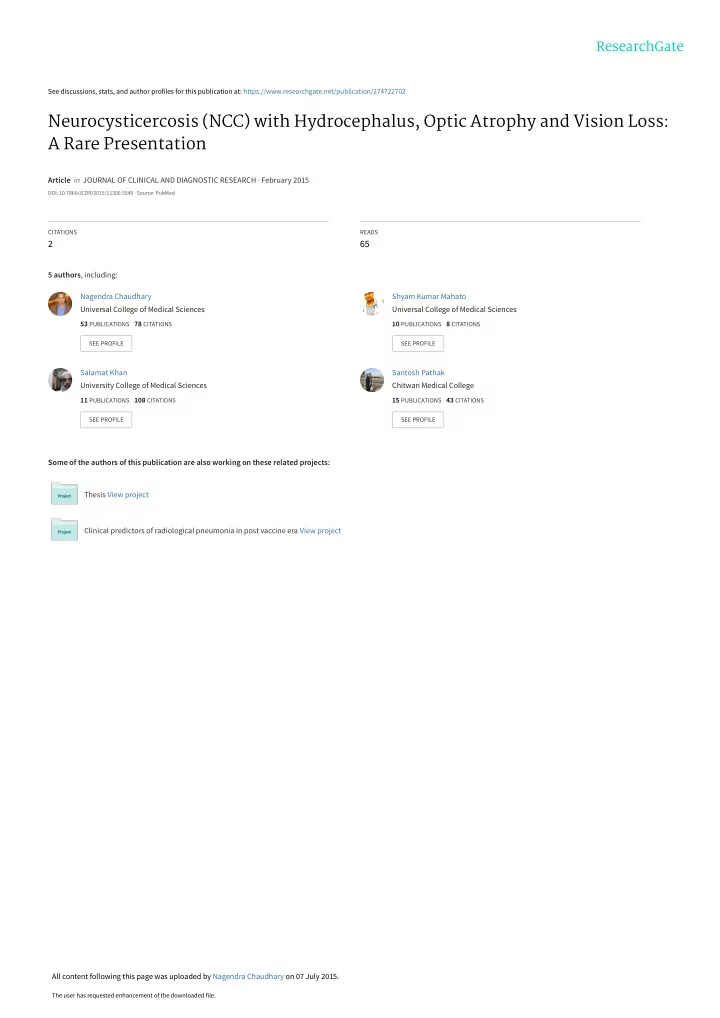

See discussions, stats, and author profiles for this publication at: https://www.researchgate.net/publication/274722702 Neurocysticercosis (NCC) with Hydrocephalus, Optic Atrophy and Vision Loss: A Rare Presentation Article in JOURNAL OF CLINICAL AND DIAGNOSTIC RESEARCH · February 2015 DOI: 10.7860/JCDR/2015/11300.5549 · Source: PubMed CITATIONS READS 2 65 5 authors , including: Nagendra Chaudhary Shyam Kumar Mahato Universal College of Medical Sciences Universal College of Medical Sciences 53 PUBLICATIONS 78 CITATIONS 10 PUBLICATIONS 8 CITATIONS SEE PROFILE SEE PROFILE Salamat Khan Santosh Pathak University College of Medical Sciences Chitwan Medical College 11 PUBLICATIONS 108 CITATIONS 15 PUBLICATIONS 43 CITATIONS SEE PROFILE SEE PROFILE Some of the authors of this publication are also working on these related projects: Thesis View project Clinical predictors of radiological pneumonia in post vaccine era View project All content following this page was uploaded by Nagendra Chaudhary on 07 July 2015. The user has requested enhancement of the downloaded file.
DOI: 10.7860/JCDR/2015/11300.5549 Case Report Neurocysticercosis (NCC) with Paediatric Section Hydrocephalus, Optic Atrophy and Vision Loss: A Rare Presentation NAGENDRA CHAUDHARY 1 , SHYAM KUMAR MAHATO 2 , SALAMAT KHAN 3 , SANTOSH PATHAK 4 , B.D BHATIA 5 ABSTRACT Neurocysticercosis (NCC) is one of the most common parasitic infestations (Taenia solium) of central nervous system (CNS) in children. Seizures are the common presenting symptoms. Hydrocephalus and optic atrophy are rare complications which may require neurosurgical interventions. We report a case of NCC with hydrocephalus and bilateral optic atrophy associated with vision loss in a Nepalese patient who improved with anti-parasitic therapy followed by ventriculo-peritoneal (VP) shunting. Keywords: Central nervous system, Parasitic infestations, Taenia solium CASE REPORT day). Repeat MRI [Table/Fig-4] after one month was suggestive of worsening of hydrocephalus with periventricular ooze. A VP shunt An 8-year-old male from western Nepal presented with history was put. On 12 months follow up, there was no evidence of shunt of bilateral frontal headache for six months, blurring of vision, blockage and child had improvement in visual acuity. and double vision with progressive decrease in visual acuity for one month. On presentation, he could view objects at a distance DISCUSSION of about 30-35 cm but could not identify their colour. There was NCC, one of the most common helminthic infestations of the no history of seizures. He had normal developmental history with brain, is highly prevalent in countries like India and Nepal.WHO no regression of any milestones. Birth history was uneventful. He estimates that more than 50,000 deaths occur every year due to was immunized appropriately. On examination, vitals were stable. NCC. CNS involvement is seen in 60–90% of infested patients [1]. CNS examination revealed bilateral equal symmetrical pupils, Cerebrum and cerebellum are common sites but cysticerci may sluggishly reacting to light with intact consensual light reflex.Visual involve brainstem, basal ganglion, thalamus and lateral sinus as well. acuity revealed finger counting up to 30-35 cm distance. Colour The larval stage of T. solium can migrate to any organ in the body, vision was absent. Fundus examination showed bilateral pale disc but most reports have focused on cysts located in the CNS, eyes, with features suggestive of optic atrophy. There was UMN type muscles or subcutaneous tissues [2]. Intraventricular (5–10%) and facial palsy with no other neurological deficits. Other systemic meningeal cysticerosis are associated with hydrocephalus, signs of examination was normal.Complete blood count and chest X-ray meningeal irritation and raised intracranial pressure [1]. were normal. Mantoux test was negative. Magnetic resonance imaging (MRI) of brain revealed ring enhancing lesions (active stage) The clinical manifestation depends on the location of the cyst in multiple locations, bilateral hydrocephalus with diffuse high signal along with the host`s immunity [3]. Seizures are the most common intensity involving periventricular white matter, cerebellum and sub manifestations followed by headache, hydrocephalus, chronic cortical U fibers as shown in [Table/Fig-1-3]. Child was treated with meningitis, focal neurological deficits and psychological disorders [4]. Methyl Prednisolone (30 mg/kg/day) for five days followed by oral It is the most common cause of acquired epilepsy and neurological Prednisolone (2 mg/kg/day) for 28 days and finally tapered and morbidity in many developing countries [3]. Studies from India stopped. Albendazole (15 mg/kg/day) was given for 28 d. He was suggest that seizures/epilepsy is common in children than adult also given Phenytoin (5 mg/kg/day) and Acetazolamide (30 mg/kg/ population [5]. A community based survey conducted [6] in Morang [Table/Fig-1-3]: Magnetic resonance imaging (Transverse, sagittal and coronal sections) showing multiple NCC with hydrocephalus 1 Journal of Clinical and Diagnostic Research. 2015 Feb, Vol-9(2): SD01-SD02
Recommend
More recommend